|
Related FAQs: TWA
Invertebrates, Fishes of the Tropical
West Atlantic, Tropical West Atlantic
2,
Related Articles: Algae,
Vascular Plants, Introduction
to Fishwatcher's Guide Series Pieces/Sections, Lachnolaimus maxiumus/Hogfish, Hogfishes of the Genus
Bodianus,
Invertebrates, Algae and Vascular
Plants of The Tropical West Atlantic: Bahamas to Brazil, Part
6
To: Part 1, Part 2, Part 3,
Part 4, Part
5, Part 7, Part 8, Part 9,
|
 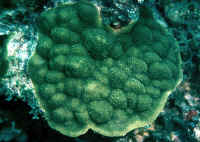
|
| Bob Fenner |
Stony Corals
|
Family Acroporidae, Classification:
Staghorn corals come in many shapes and all colors... and these
traits can be highly variable per species. Most are typically branched,
table-top shaped, or encrusting per type, but colors often ran the
gamut of browns, whites to pinks, blues, yellows, greens, even purple,
depending on growing conditions. As with other true or stony corals
(Order Scleractinia) real determination to the species level rests on
close examination of corallites (individual polyp skeletons),
biochemical and genetic study.
| Acropora cervicornis, one of three Staghorn Corals
of the tropical Western Atlantic. To eight feet in height, branches
to more than an inch diameter. Cozumel image. |

|
| Acropora palmata, Elkhorn Coral. Found in the
tropical West Atlantic. Established stands are 3-12 feet in
diameter, with branches of 2-10 inch width. Occasionally
"occurs" on live rock cultured for the trade. Pictured, a
large stand in Belize and a budding colony in an
aquarium. |
  |
| Acropora prolifera, the Fused Staghorn. Photos of
a colony in Cancun, Mexico, and a "found" cultured
specimen in captivity. |
 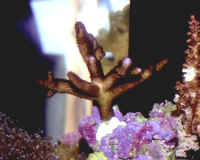 |
Family Poritidae:
| Porites asteroides Mustard Hill Coral. Form
encrusting colonies in shallows to domes in calmer, deeper water.
Three Bahamian specimens below. First two from the shallows are
close ups. Cozumel close-up by Di.F at right. |
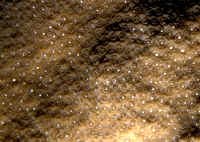
|
| Porites porites (Pallas 1776), Finger
Coral. Smooth appearing branches with embedded polyps.
Generally tannish to brown in color but may be blue, purple. Open
polyp (nighttime) feeding detail at right in the Bahamas. A
close up below and a very small colony in an Eelgrass bed in Belize
and an larger colony in the Bahamas. |

|
Family Meandrinidae: Easily mistaken for faviids, the widely
separated species of Meandrinid corals can be discerned by their solid
skeletal structure. With polyps closed their corallites septa are
clearly seen as prominent, exsert (sticking out), of equal size and
spacing.
Three genera (Eusmilia, Gyrosmilia and Montigyra)
were moved by Veron (2000) to here from the Caryophylliidae. Four
genera in the tropical West Atlantic, three in the eastern Indian Ocean
and Red Sea.
| Dendrogyra cylindrus, Pillar Coral. Upright,
generally arising from sandy areas. Polyps typically open, feeding
during the day. Cancun, Mexico image. |
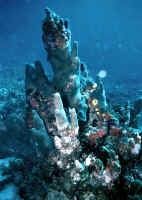
|
| Dichocoenia stokesii Mile Edwards &
Haime 1848, Elliptical Star Coral. Flattened plates or
boulder-shaped. Corallites spaced evenly. Bahamas photos of a
plate-like colony, close-up of a typical shallow water and deeper,
more-shaded colony. Bahamas pix. |
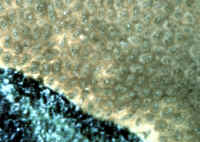
|
| Eusmilia fastigiata (Pallas
1766) . Typically dome-shaped, phaceloid colonies with
well-spaced tubular corallites. Found sparsely throughout the
tropical West Atlantic. Extends tentacles at night. Images
taken in Bahamas of small and large brown colonies at right, and
Tobago and at night, feeding in Bonaire below. |
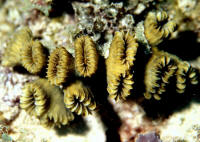
|
| Meandrina meandrites (Linnaeus 1758), Maze,
Butter Print, Tan Brain Coral. Occurs as flattened and
hemispherical colonies. Thin ridge at top of septa where plates
come together. Right, at night in Bonaire. Bahamas photos
below. |
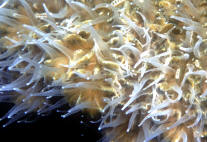
|
To: Part 1, Part
2, Part 3, Part
4, Part 5, Part
7, Part 8, Part
9, Part 10, Part
11, Part 12, Part
13, Part 14, Part
15,

